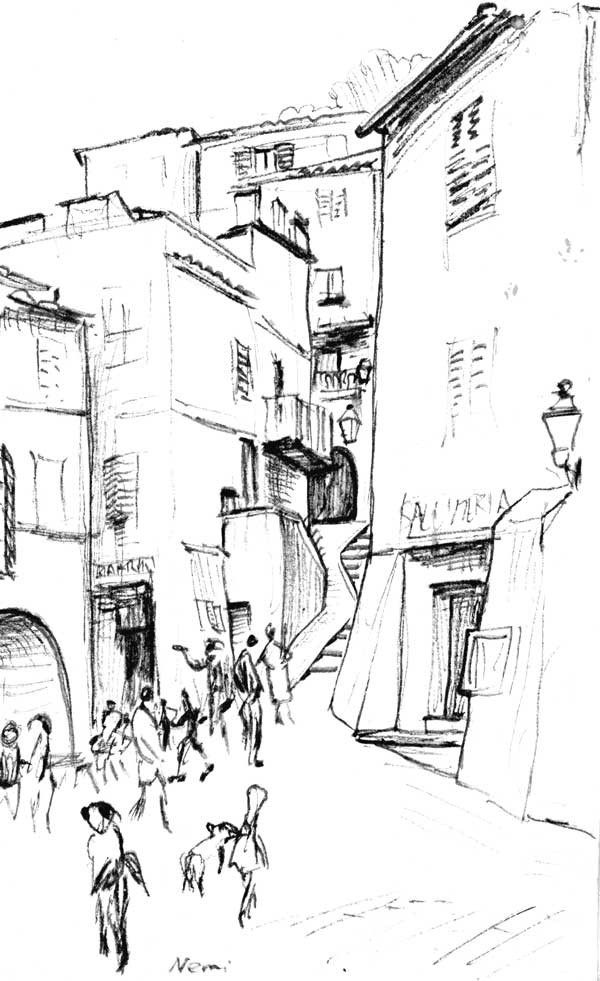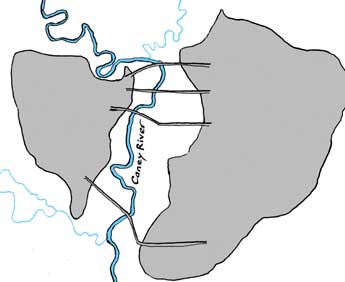|

Preface
This is not a guidebook. What I want to say about each place is
far from being complete, or proportionate, or according to a uniform
plan, or even fair. I've picked out aspects of places that I found
striking and interesting.
At first the title
that came into my head was “The Structures of Nineteen Cities.”
It just sounded like a saleable title. It suggested that the world's
major places are to come (which they may or may not). Why nineteen?
There may or may not be nineteen in the end.
And though “Cities”
has a ringing sort of appeal, I want to be able to include some
smaller places. English doesn't seem to have a term, except possibly
“settlement,” covering the continuum from city to town
to village to hamlet to even smaller groups of habitations such
as communes and farms. The present understanding is vaguely that
cities are large towns, so you could could call Chicago a town but
you could hardly call Pumpkintown a city. There is a supposed distinction,
in Britain, that cities are defined by having cathedrals. Yet in
the English of the King James Bible, every little dwelling of the
Hivites and Benjamites is a “city.”
Other categories
get invented, and here's one I've just learned of in the U.S.A:
the CDP or “census-designated place.” It's a physical
community that is not a municipality — has no municipal government
— unlike the “incorporated places” which are cities,
towns, and villages. It is, or may be, designated for the ten-year
census, so it has a sort of fleeting existence. An example of a
CDP is Tuckapaw, South Carolina, a little community whose fine old
Cherokee name is worth mentioning — indeed, keeping alive —
because it got changed to “Startex” by the factory dominating
it. Officially, there is no more Tuckapaw and not even a town on
the spot, only and briefly a CDP called Startex; but the inhabitants,
I think, would still say they live in Tuckapaw the town.
I think “town”
is the best all-round word. It is native English, whereas all the
other words, except for “township” and “borough,”
are from Latin through French (civitas, cité, city). Anglo-Saxon
tun, with a long vowel, meant originally a twig, then a hedge,
then a hedged enclosure, then a farmstead. The word by itself developed
into town, but used as an ending it gave us the thousands
of names in -ton. East tun, “eastern farmstead,”
became Aston; ac tun, “oak farmstead,” became Acton; Bicas tun, “farmstead of
a man called Bica,” became Bickton; beretun, “barley-enclosure,”
became barton, an old word for “farmyard” (Hardy's
Festus Derriman, in The Trumpet-Major, jokes that his miserly
uncle lives on “the sweepings of the barton!”), then the
name of many plsces, and hence a surname. Starting from the smallest
end of the continuum, town extends to the largest: we can
talk of “London town” and of going “down town”
in New York.
And “town,”
to me, is a satisfyingly noisy little word; it resonates with the
shouts and clangor of streets, and is tight like the clustering
of structures and passages that gets denser toward the centre of
real old towns — I now think of Axminster in Devon as a type-specimen
of town-ness.
What about “structure”?
I enjoy structure and notice it. As do others: amateurs of astronomy,
for example, relish seeing “structure” in the tail of
a comet or in the corona of the sun during an eclipse, and want
to manipulate photographs until they show it as the eye does. The
structure of a town may arise from geology, or topography, or history;
in turn it helps to determine further history, and population, and
prosperity, and character, and personality.
 For instance, when
I was once taken to stay briefly in Bartlesville, Oklahoma, I learned
that it was the city of Phillips Petroleum, and that it was divided
into halves by the mile-wide floodplain of a river, crossed only
by a few causeways. In the eastern half lived the executives, and
over on the west, crowded around some big buildings, lived the company's
humbler workers. The west side is the “downtown”and the
capital of a county; the sprawling newer east side is in a different
county. That is probably a simplification, and there is no doubt
much more to say about Bartlesville, but the pattern stood out and
is interesting, and might make a workable start for a fuller description.
For instance, when
I was once taken to stay briefly in Bartlesville, Oklahoma, I learned
that it was the city of Phillips Petroleum, and that it was divided
into halves by the mile-wide floodplain of a river, crossed only
by a few causeways. In the eastern half lived the executives, and
over on the west, crowded around some big buildings, lived the company's
humbler workers. The west side is the “downtown”and the
capital of a county; the sprawling newer east side is in a different
county. That is probably a simplification, and there is no doubt
much more to say about Bartlesville, but the pattern stood out and
is interesting, and might make a workable start for a fuller description.
But sometimes I
want to remark on something that isn't structure or could only at
a stretch be called structure, such as the street-names of Mérida.
|


 For instance, when
I was once taken to stay briefly in Bartlesville, Oklahoma, I learned
that it was the city of Phillips Petroleum, and that it was divided
into halves by the mile-wide floodplain of a river, crossed only
by a few causeways. In the eastern half lived the executives, and
over on the west, crowded around some big buildings, lived the company's
humbler workers. The west side is the “downtown”and the
capital of a county; the sprawling newer east side is in a different
county. That is probably a simplification, and there is no doubt
much more to say about Bartlesville, but the pattern stood out and
is interesting, and might make a workable start for a fuller description.
For instance, when
I was once taken to stay briefly in Bartlesville, Oklahoma, I learned
that it was the city of Phillips Petroleum, and that it was divided
into halves by the mile-wide floodplain of a river, crossed only
by a few causeways. In the eastern half lived the executives, and
over on the west, crowded around some big buildings, lived the company's
humbler workers. The west side is the “downtown”and the
capital of a county; the sprawling newer east side is in a different
county. That is probably a simplification, and there is no doubt
much more to say about Bartlesville, but the pattern stood out and
is interesting, and might make a workable start for a fuller description.